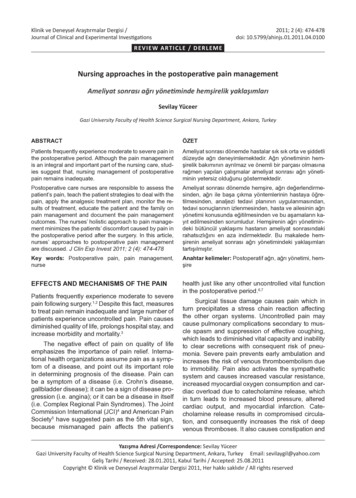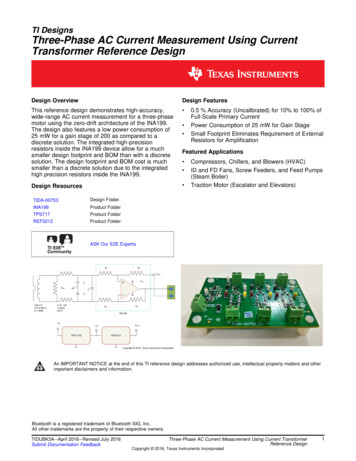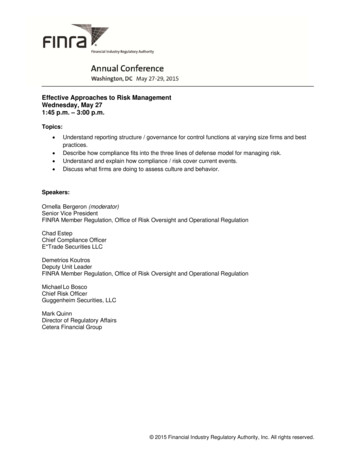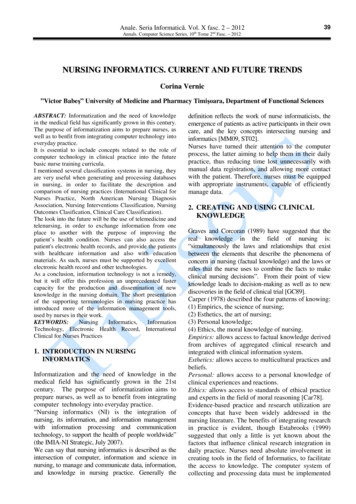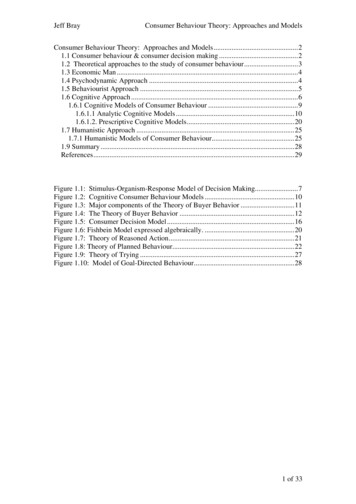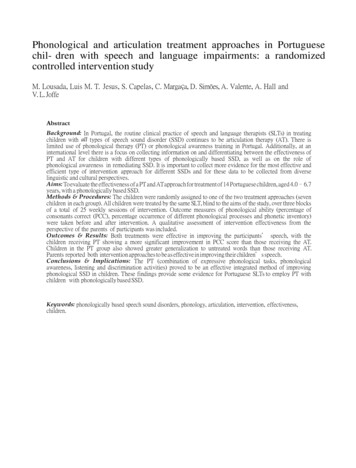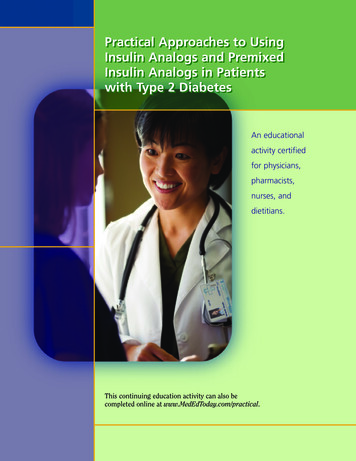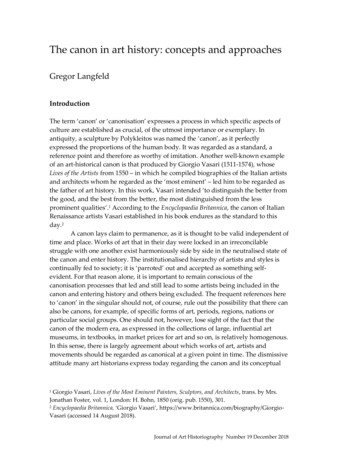
Transcription
CE 1.5HOURSContinuing EducationPreeclampsia:Current Approaches toNursing ManagementA clinical review of risk factors, diagnostic criteria, and patient care.ABSTRACT: Preeclampsia, one of four hypertensive disorders of pregnancy, has traditionally been characterized as new-onset hypertension and proteinuria developing after 20 weeks’ gestation. It is, however, nowunderstood to be a complex, progressive, multisystem disorder with a highly variable presentation and anumber of potentially life-threatening complications. The American College of Obstetricians and Gynecologists Task Force on Hypertension in Pregnancy has refined preeclampsia diagnostic criteria accordingly, andas the disorder’s pathogenesis has been more clearly defined, new targets for screening, diagnosis, prevention, and treatment have emerged. This clinical update provides a review of current practice related to preeclampsia risk assessment, prediction, and management. It discusses preeclampsia pathophysiology andpoints readers to valuable health care resources on the topic.Keywords: clinical management, nursing care, preeclampsia, pregnancy complication, pregnancy-inducedhypertension, risk factorsKW was a healthy 35-year-old woman whoselife was forever changed when she developedsevere and life-threatening complications during the latter half of her second pregnancy. (Thiscase is real, based largely on the patient’s description of her experience of the events. Identifyingdetails have been omitted to protect the patient’sprivacy.) KW’s one previous pregnancy had endedwith a first-trimester miscarriage. Her second pregnancy had been unremarkable until 31 weeks’ gestation. Throughout this pregnancy, she had receivedroutine prenatal care from her obstetrician as wellas intermittent follow-up from a maternal–fetal medicine specialist because of her advanced maternal age.For the first 30 weeks, KW’s pregnancy progressedsmoothly. She attended all of her prenatal checkups,maintained a healthy diet and an active lifestyle, and30AJN November 2017 Vol. 117, No. 11did everything she could to ensure a healthy pregnancy. But at 31 weeks, KW began to show signsand symptoms of preeclampsia.First, she developed excruciating pain in her upper right side. A trip to the perinatal triage unit revealed that her blood pressure was on the high endof normal, she had protein in her urine, and herplatelet count was at the low end of normal. Withanalgesia, the pain in her right side resolved, and after eight hours of close observation, she was senthome. The focus of KW’s care plan became “expectant management,” with preparation for delivery atno more than 37 weeks’ gestation and intensive maternal and fetal monitoring, the frequency of whichwas based on findings of maternal and neonatal surveillance. Over the next several weeks, KW’s monitoring includedajnonline.com
By Cindy M. Anderson, PhD, CRNP, ANEF, FAHA, FAAN, andMandy J. Schmella, PhD, RNFigure 1. Possible Physiological Changes in PreeclampsiaVasoconstriction and decreased perfusion to thematernal brain and liver can lead to headache,seizures, vision changes, impaired liverfunction, and epigastric pain.BrainDecreased kidney perfusion can cause activationof the renin–angiotensin–aldosterone system,worsening vasoconstriction.Impaired maternal spiral artery remodeling duringdevelopment of the placenta results in narrowvessels with high resistance and decreasedplacental perfusion.KidneysLiverPlacentaThe placenta, damaged by impaired perfusion,releases excessive proinflammatory andantiangiogenic factors into the maternal circulation,which in turn cause endothelial damage,vasculopathy, vasospasm, altered hemostasis,and activation of the coagulation system.Bladder home blood pressure monitoring. weekly fetal nonstress tests. weekly visits with the maternal–fetal medicinespecialist and the obstetrician. 24-hour protein measurements. weekly blood samples to measure completeblood count, as well as levels of liver enzymesand serum creatinine. ultrasound, performed weekly for measurementof amniotic fluid index and every three weeksfor fetal growth assessment.At 35 weeks and three days’ gestation, KW developed a persistent headache. Although she knew thiswas a warning sign of preeclampsia, she believes shewas in denial. She wanted to hold onto her pregnancy as long as possible and thought she could putoff telling the maternal–fetal medicine specialist untilher appointment two days later. Her headache continued, and at her appointment, her blood pressureajn@wolterskluwer.comIllustration by Sara Jarret.Endothelial dysfunction can increase blood vesselpermeability, leading to edema and proteinuria.Endothelial damage results in vasoconstriction,coagulopathies, and increased risk of bleeding.was 160/110 mmHg. Her physician told her that herpregnancy was over, and she agreed to be admittedfor induction.Because KW’s platelet count was extremely low(33,000 per microliter, as she recalls), the physicianswere concerned about her bleeding risk. For this reason, they opted to induce labor rather than to proceed immediately to epidural placement and cesareansection. Over a 26-hour labor, however, KW’s condition further deteriorated. Although she was receiving a continuous iv infusion of magnesium sulfate forseizure prophylaxis, after 24 hours of labor her vision became gradually blurry, she started seeing spots,and eventually, she saw nothing but “a white blur.”Soon after her loss of vision, she had a seizure, indicating that her condition had advanced to eclampsia(pregnancy-related seizures). This life-threateningdeterioration led to an emergency cesarean delivery,multiple platelet transfusions, an ICU stay, and—AJN November 2017 Vol. 117, No. 1131
owing to his prematurity—a neonatal ICU stay forher newborn son for monitoring of lung function andbilirubin levels.While KW was recovering from her cesarean section, her vision returned. Remarkably, just 36 hoursafter giving birth to a healthy baby boy, KW was ableto walk to the neonatal ICU to see and breastfeed herson for the first time. A little less than a week afterdelivery, KW and her son were discharged from thehospital. KW recovered from the acute symptoms ofpreeclampsia. Following delivery, however, she developed chronic hypertension requiring antihypertensivetherapy, and one year after the birth of her son, sheexperienced a second seizure. Although she was diagnosed with a mild seizure disorder, she has been seizure free for two years. She understands that a historyof preeclampsia puts her at elevated risk for cardiovascular disease, necessitating annual cardiovascularscreening.KW’s case is presented here to set the stage for aclinical update on preeclampsia–eclampsia, one offour hypertensive disorders of pregnancy (see TheHypertensive Disorders of Pregnancy1). KW had developed a severe form of preeclampsia, which wascomplicated by the syndrome known as HELLP (inwhich the patient exhibits hemolysis, elevated liver enzymes, and a low platelet count) and eventually progressed to eclampsia. This article provides nurses withcurrent information related to diagnosis, pathophysiology, risk factors, prediction, prevention, and management of preeclampsia. It further suggests preeclampsiaresources for use by nurses, pregnant women, andpreeclampsia survivors.PREECLAMPSIA REDEFINEDAlthough preeclampsia has traditionally been defined by the presence of new-onset hypertension andproteinuria after 20 weeks’ gestation, the AmericanCollege of Obstetricians and Gynecologists (ACOG)Task Force on Hypertension in Pregnancy emphasizes that it is a complex, progressive, multisystemdisorder of pregnancy that can present in differentforms, with some women experiencing unremittingheadaches or severe right upper quadrant pain andothers experiencing no symptoms before prenatalvisits reveal they have elevated blood pressure andprotein in their urine. The ACOG Task Force has refined the diagnostic criteria accordingly (see Table 11).Based on evidence that proteinuria is neither a robust predictor nor the sole predictor of adverse outcomes, it was removed both as an indicator of severepreeclampsia and as a necessary criterion for preeclampsia diagnosis.1-3 Women with either proteinuricor nonproteinuric preeclampsia are at risk for adverseoutcomes and require increased maternal and fetal surveillance.4, 5 In 2000, the National High Blood PressureEducation Program of the National Heart, Lung, andBlood Institute had removed edema from the diagnostic criteria because it is common in women withnormal pregnancies; in addition, it removed systolicblood pressure increases of 30 mmHg or diastolicblood pressure increases of 15 mmHg in women withblood pressure below 140/90 mmHg, because suchwomen are not more likely to have adverse outcomes.6Recommended terminology. The ACOG TaskForce has also recommended changes in the terminology used to describe the severity of preeclampsia.They suggest that the term “preeclampsia withoutsevere features” be used instead of “mild preeclampsia.”1 In addition to the multisystem findings listed inTable 1, either of the following would be considereda severe feature of preeclampsia1: systolic blood pressure at or above 160 mmHg ordiastolic blood pressure at or above 110 mmHgThe Hypertensive Disorders of PregnancyThe four hypertensive disorders of pregnancy are classified as follows1: chronic hypertension—hypertension of any cause that predates pregnancy or develops before 20 weeks’gestation gestational hypertension—new-onset hypertension that develops in a previously normotensive womanafter 20 weeks’ gestation in the absence of proteinuria preeclampsia–eclampsia—new-onset hypertension that develops in a previously normotensive womanafter 20 weeks’ gestation and is accompanied either by new-onset proteinuria or, in the absence of proteinuria, by signs of multisystem involvement, such as thrombocytopeniaoo preeclampsia is said to progress to eclampsia if convulsions occuroo preeclampsia–eclampsia may be accompanied by the following group of laboratory findings: hemolysis,elevated liver enzymes, and a low platelet count, known as the HELLP syndrome, which is often considered a subtype of preeclampsia chronic hypertension with superimposed preeclampsia—preeclampsia that develops in a woman withchronic hypertension32AJN November 2017 Vol. 117, No. 11ajnonline.com
Table 1. Diagnostic Criteria for PreeclampsiaBlood pressure Greater than or equal to 140 mm Hg systolic or greater than or equal to 90 mm Hgdiastolic on two occasions at least 4 hours apart after 20 weeks of gestation in a womanwith a previously normal blood pressure Greater than or equal to 160 mm Hg systolic or greater than or equal to 110 mm Hgdiastolic, hypertension can be confirmed within a short interval (minutes) to facilitatetimely antihypertensive therapyandProteinuria Greater than or equal to 300 mg per 24-hour urine collection (or this amountextrapolated from a timed collection)or Protein/creatinine ratio greater than or equal to 0.3a Dipstick reading of 1 (used only if other quantitative methods not available)Or in the absence of proteinuria, new-onset hypertension with the new onset of any of the following:Thrombocytopenia Platelet count less than 100,000/microliterRenal insufficiency Serum creatinine concentrations greater than 1.1 mg/dL or a doubling of the serumcreatinine concentration in the absence of other renal diseaseImpaired liver function Elevated blood concentrations of liver transaminases to twice normal concentrationPulmonary edemaCerebral or visual symptomsaEach measured as mg/dL.Reprinted with permission from the American College of Obstetricians and Gynecologists Task Force on Hypertension in Pregnancy. Hypertension in pregnancy. Washington,DC; 2013.1on two occasions at least four hours apart in apatient on bedrest, unless antihypertensive therapy had been initiated previously severe and persistent right upper quadrant or epigastric pain that does not resolve with medicationand is not explained by alternative diagnosesFREQUENCY, MORBIDITY, AND MORTALITYIn the United States, preeclampsia complicates 2.3%to 3.8% of pregnancies.7, 8 Globally, it’s estimated toaffect 4.6% of pregnancies,7 though frequency variesby region, being reportedly as low 0.2% in Vietnamand as high as 7.67% in Nicaragua.9Despite the relatively low percentage of pregnancies affected by preeclampsia, it remains a leadingcause of maternal morbidity and mortality. Hypertensive disorders are responsible for roughly 14% ofpregnancy-related maternal deaths worldwide10 andabout 7.4% of such deaths in the United States11—and preeclampsia is the most common hypertensivedisorder of pregnancy.1 Preeclampsia can affect virtually every organ system, putting the mother at riskfor a host of morbidities, including disseminated intravascular coagulation and respiratory, cardiovascular, cerebrovascular, liver, kidney, uterine, andneurologic dysfunction.9, 12-14For infants exposed to preeclampsia in utero, preeclampsia-related morbidity is associated primarilyajn@wolterskluwer.comwith prematurity, though these infants tend to havean unfavorable cardiometabolic profile (that is, elevated blood pressure, a high body mass index [BMI],or signs of altered cardiac function and structure) inadolescence or adulthood.15-18 Despite the significanthealth burden that preeclampsia places on womenand their infants, no test can reliably predict preeclampsia and no known practices can prevent itsoccurrence. Clinical management of preeclampsia is,therefore, symptom based, and the only known curefor preeclampsia is delivery.PATHOPHYSIOLOGY OF PREECLAMPSIADepending on time of onset during gestation, preeclampsia may represent more than a single condition or include disease subtypes with different causesand clinical presentations. Current evidence suggeststhat the pathogenesis of preeclampsia proceeds instages.19 The early stages occur du
preeclampsia–eclampsia—new-onset hypertension that develops in a previously normotensive woman after 20 weeks’ gestation and is accompanied either by new-onset proteinuria or, in the absence of pro-teinuria, by signs of multisystem involvement, such as thrombocytopenia o preeclampsia is said to progress to eclampsia if convulsions occur
